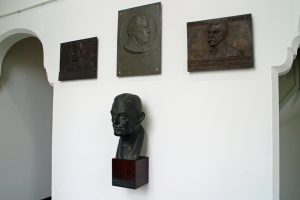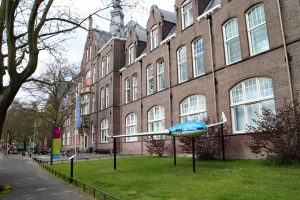Posted in 2020
The Delft School photograph collection
The Delft School of Microbiology has a rich collection of photographs. As I mentioned in an earlier post (23 September, 2020), we have recently been able to have many of them professionally scanned, thanks to a grant from the Prins Bernhard Cultuurfonds, and I thought that readers might like to see some of the results.
Before travel became so convenient, it was common to exchange photographs with colleagues and friends, especially if you were collaborating with them. As you can see from the photo below, Kluyver liked to exhibit some of these photos over his desk.
Some of those photos can be seen below.
Another common subject in the collection’s photographs features groups of people.
As many people who teach large numbers of students in a year will agree, the most efficient way to start each course is to photograph the group and add their individual names. Professor van Iterson photographed all of his practical courses, and attached each photograph to a transparency numbering the people, and a list of the names. 2 examples are shown below.
Photographs of small and large groups also occur frequently. The examples presented here show small and larger conference photographs, Professor Kluyver and his staff, some time after World War II, Professor van Iterson on one of his visits to Indonesia, and Prins Bernhard being awarded an Honorary Doctorate by Professor Kluyver.
I must repeat my thanks to the Prins Bernhard Cultuurfonds for funding the scanning of our photo collection. Not only does it make research and publishing of the images easier, but we are currently packing up the collection to move to other buildings and the complete set of scanned images serves as a form of insurance against loss or damage during the moves.
Buried treasure in the archives
We’ve been put into a form of lockdown again. This has provided me with time to search through archive boxes and confirm that they actually contain what I thought they did. For some years, we have had a stack of boxes which previously belonged to one of Kluyver’s most famous students, C.B. van Niel. After he obtained his Doctorate, Van Niel left Delft for Stanford University in the USA (where he introduced the term “Delft School of Microbiology”). After his death, they were sent to the University of Groningen, and thence to us in Delft for safe keeping. Most of the boxes were full of Van Niel’s reprint collection, but some contained books so I added three of them to my homework for the new lockdown.
And then I struck gold.
Two of the boxes were full of exercise books and loose-leaf files, some with Van Niel’s name on them. Only one has the address of Kluyver’s lab in Delft, the others date from Van Niel’s lab at Pacific Grove in the 1930s. All of them are full of his experiments in great detail, and they are absolutely fascinating. The third box contains some letters, lecture notes and a file full of science-related jokes.
When the biosafety restrictions are relaxed a bit and we’re allowed back into the archive, I’ll be checking the rest of the Van Niel stack. The moral of this tale is check every box and file, you never know what it contains!
And the research goes on!
A couple of readers have asked about whether research into different aspects of the Delft School will still be possible in the future, and the answer is yes, of course. We have had volunteers scanning the fragile papers and notebooks for years and, thanks also to a group of Delft students last summer, about half the papers have been scanned. Eventually, the rest of the papers will also be scanned and it will be possible to research everything from the scans without having to handle the (sometimes very fragile) original papers.
They will be in the best possible place – a purpose-built archive with professional archivists.
All good things…
Museum and Archive Updates
This has been a good week for the Collection. Thanks to a generous grant from the Prins Bernhard Cultuurfonds, we have been able to get our large collection of photographs professionally digitized, and on Monday the project was completed. The photos and their image files all came home.
Before travel became convenient and relatively fast, it was common to exchange photographs with colleagues, some of which can be seen over the Professor’s desk in the Beijerinck Museum. We have a number of such pictures, ranging from the famous (eg Winogradsky and Waxman) to staff, students and Beijerinck’s family, among other subjects. The photographs over the desk change, depending on who is coming to visit us. The collection also holds photographs of equipment, the labs at various dates, students and staff, as well as international visitors and microorganisms. Now that the photograph collection has been digitized, it will be catalogued in the University’s online catalogue.
None of this this would have been possible without the support of the Prins Bernhard Cultuurfonds, and we are very grateful to them.
On a sadder note, the building that the collection currently calls home has been sold, and we should be moving in the second half of next year. I will, of course, provide more details when I have them.
To end with something exciting, among recent donations to the collection was a set of exercise books found during a family house clearance. In these days of printed lecture notes, it is frustrating that such things did not exist in the late 19th/early 20th centuries so that we only know Beijerinck’s work from his publications. It was therefore very exciting to find that these books contained notes made by a student (the grandfather of the donor) during the Professor’s lectures. They were immediately scanned by a museum assistant, and then stored in our fire-proof safe. The current virus-related lockdown has given me time to look through them and I am very excited. The notes are not only beautifully illustrated and legibly handwritten, they are very detailed. At last we can find out what Professor Beijerinck told his students!



























Recent Comments